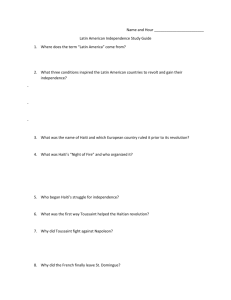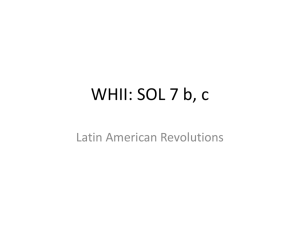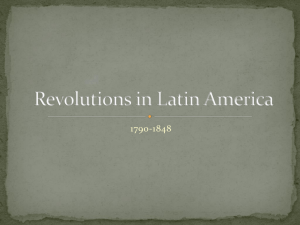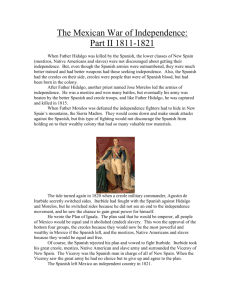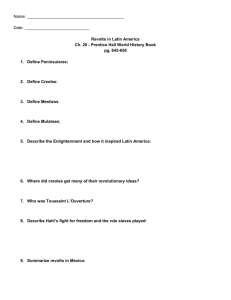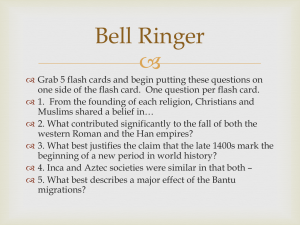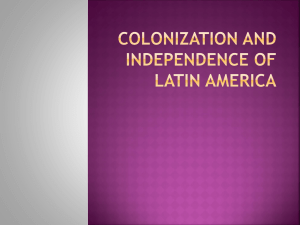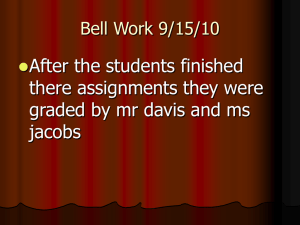Revolts in Latin America
advertisement
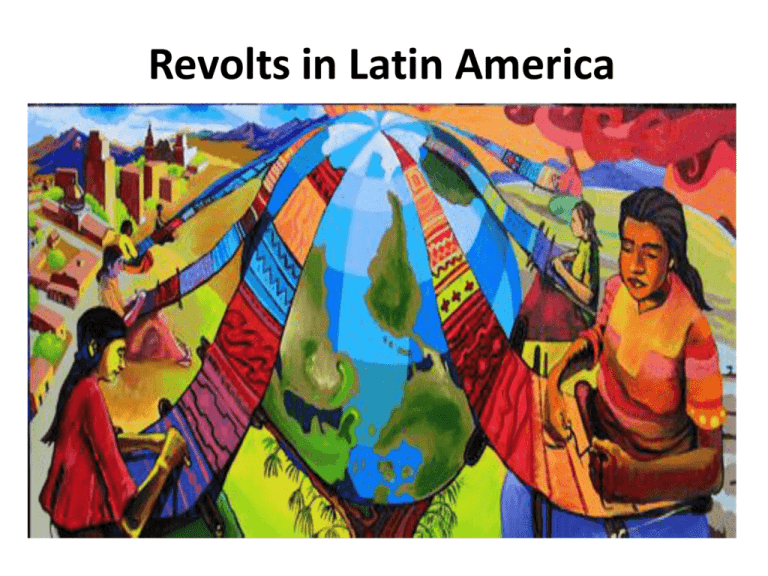
Revolts in Latin America “I swear before God and by my honor never to be idle nor my soul to rest until I have broken the chains that bind us to Spain.” –Simon Bolivar Discontent Fans the Fire • Discontent in Latin America was rooted in the social, racial, and political system that emerged during 300 years of Spanish rule. • Social (classes) and Ethnic structures cause resentment. Peninsulares -Members of the highest social class. -Dominated political/social life. -Held top government jobs and the Church. Creoles -Owned the haciendas, ranches and mines. -Resented their second class status. -Merchants were concerned with mercantilist policies that tied the colonies to Spain. Mestizos/Mulattoes Native Americans -Were people of Native American and European descent-were angry at being denied status, wealth and power that were available to whites. -Native Americans suffered economic misery under the Spanish, who conquered their lands. Mestizos Mulattoes The Enlightenment Inspires Latin Americans • In the 1700s educated creoles read the works of Enlightenment thinkers. • Translations of the Declaration of Independence and the U.S. Constitution circulated among the creole elite. • Simon Bolivar, a young creole, traveled in Europe during the French Revolution. He was inspired by the ideals of “liberty, equality, and fraternity.” • Many creoles were still reluctant to act. Napoleon Invades Spain • Widespread rebellion finally occurred in Latin America after Napoleon’s invasion of Spain in 1808. • Napoleon ousted the Spanish king and placed his brother, Joseph Bonaparte on the Spanish throne. • In Latin America, leaders saw Spain’s weakness as an opportunity to reject foreign domination. • They now began to demand independence from colonial rule. Hispaniola pg. 157 Slaves Win Freedom for Haiti • Revolution had erupted in the French-ruled colony of Hispanolia (Haiti). • French planters owned very profitable sugar plantations worked by nearly a half million enslaved Africans. • The slaves were overworked and underfed. • Embittered by suffering and inspired by the talk of liberty, the island’s slaves rose up in a revolt in 1791. • The rebels were fortunate to find an intelligent and skillful leader in Toussaint L’Ouverture, a self educated former slave. • Although untrained, Toussaint was a brilliant general and inspiring commander. Haiti Wins Independence • France, Spain, and Britain all sent armies against Toussaint’s rebel armies. • The fighting took more lives than any other revolution in the Americas. • By 1798, slavery was finally abolished, as Toussaint’s forces controlled most of the island. • In 1802, Napoleon sent a large army to reconquer the former French colony. Toussaint’s army was ready to fight. • In April, 1802, the French agreed to a truce, but then captured Toussaint and carried him in chains to France where he died a year later in a cold mountain prison. • Finally in 1803, the French surrendered after yellow fever was destroying their army (nearly 80% = 48,000 soldiers died). • In 1804, the island declared itself independent, under the name Haiti. • However, rival Haitian leaders fought for power in the following years. • In 1820, Haiti finally became a republic. Toussaint and his Slave Rebels Mexico and Central America Revolt Father Hidalgo Cries Out for Freedom • Father Miguel Hidalgo, a creole Catholic priest, presided over the poor rural parish of Dolores, Mexico. • On September 15, 1810, Hidalgo rang the church bells summoning the people to prayer. • When they gathered, he surprised them with an urgent appeal, “My children, will you be free?” • Hidalgo’s speech became known as “el Grito de Dolores”-the cry for Dolores. • It called for Mexicans to fight for freedom! Si Se Puede! • A ragged army of poor mestizos and Native Americans marched to the outskirts of Mexico City. • Creoles rejected Hidalgo’s call for an end to slavery and his reforms to improve conditions for Native Americans. • The rebels faced a growing opposition and less than a year after he issued “el Grito”, Hidalgo was captured and executed! • His followers scattered away. Father Miguel Hidalgo is Executed Father Jose Morelos Continues the Fight • Father Jose Morelos, a mestizo priest picked up the revolution. • Morelos wanted to improve conditions for the majority of Mexicans, abolish slavery, and give the vote to all men. • For four years, Morelos led rebel forces. • He was captured and shot to death in 1815. Mexico Wins Independence • In Spain in 1820, liberals forced the king to issue a constitution. • Agustin de Iturbide, a conservative creole in Mexico, feared that the new Spanish government might impose liberal reforms on the colonies as well. • Iturbide spent years fighting Mexican revolutionaries. • Suddenly, in 1821, he reached out to the creoles, mestizos and Native Americans and they fought together to overthrow the Spanish viceroy. • Mexico was independent. • Iturbide took the title, Emperor Agustin I. • Soon, liberal Mexicans toppled the would-be monarch and established the Republic of Mexico. Agustin de Iturbide Revolution Ignites South America 1. What was Simon Bolivar’s daring plan to defeat the Spanish in Venezuela and win independence? 2. What was Simon Bolivar’s nickname? 3. What two countries did Jose de San Martin liberate from Spanish colonial rule? 4. What did Bolivar want to do with the lands he freed? What was it called? 5. Why was Bolivar frustrated before his death in 1830? 6. What did the Portuguese Royal Family do when Napoleon invaded Portugal? 7. Who did the king leave in power after he returned to Portugal? 8. What did the emperor of Brazil accept? 9. How long did Brazil remain a monarchy?
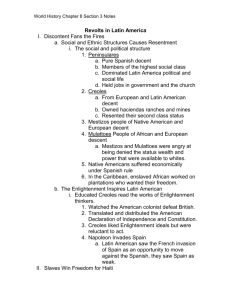
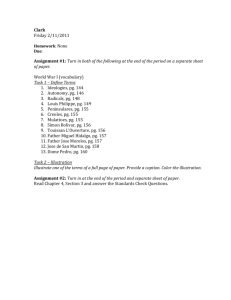
![Lesson 4.3 [WH] - MKHS](http://s3.studylib.net/store/data/008422552_1-b5d54a87b240306642b68067bfe9553e-300x300.png)
